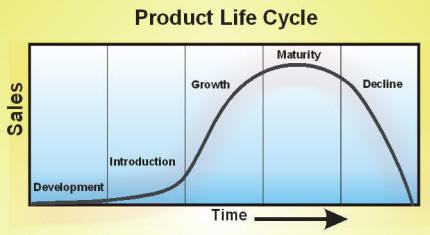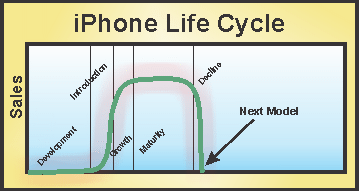|
 The
Product Life Cycle is mostly considered a Marketing and Product Design issue. But there are important
implications
for Manufacturing and Manufacturing Strategy as well. This article gives an overview of the traditional discussion of life cycles and extends that
discussion to Manufacturing Strategy. The
Product Life Cycle is mostly considered a Marketing and Product Design issue. But there are important
implications
for Manufacturing and Manufacturing Strategy as well. This article gives an overview of the traditional discussion of life cycles and extends that
discussion to Manufacturing Strategy.
The concept of a Product Life Cycle has been around for almost forever. Until Levitt's 1965 article appeared in HBR it seemed to have little use
other than as a vague framework for theoretical discussion. Levitt showed how it should lead to specific policies and actions. However, it was still about
marketing until Hayes & Wheelwright's article .
The most common life-cycle curve as shown above is a
very approximate representation. The overall timeframe may vary from a few months to decades or even centuries. The life cycle of the proverbial
buggywip was several centuries; that of the hula hoop about a year. Not only the timeframe but the shape of the
curve can be quite different for certain products and markets.
 Apple, for example, has considerably distorted the usual curve. Apple's products are typically introduced with great fanfare and sales immediately
skyrocket, level off and abruptly decline as the next model is introduced in about a year. This is a marvelous approach for companies that can attain the
status of a fashion icon. Dogbert
shows how this is done. However, the approach carries a certain risk; in the event of a quality defect, the firm's reputation can be severely damaged
for many years. Microsoft demonstrated this with Windows Vista. Apple, for example, has considerably distorted the usual curve. Apple's products are typically introduced with great fanfare and sales immediately
skyrocket, level off and abruptly decline as the next model is introduced in about a year. This is a marvelous approach for companies that can attain the
status of a fashion icon. Dogbert
shows how this is done. However, the approach carries a certain risk; in the event of a quality defect, the firm's reputation can be severely damaged
for many years. Microsoft demonstrated this with Windows Vista.
|
Development Phase
Marketing and Product Design have most of the work during development. However, Manufacturing has a valuable long-term role by ensuring that the product
is easy to manufacture with high quality.
Introduction Phase
Most products start with pilot production on a small scale. Manufacturing must plan for this and also plan for the frequent design changes that
often occur in the early phases of a product's life. Quality is critical at this point because defective product's can damage the reputation of
the product or even the entire firm. Such a reputation for poor quality may prevent or at least stifle further growth.
One exception to the above paragraph is illustrated by Apple's strategy. Here, the manufacturing challenge is to increase production from pilot to a very
large volume in a very short time. Failure to satisfy the immediate demand means lost sales and, more importantly, lost market share. Quality becomes even
more critical with this kind of marketing strategy.
Growth Phase
During growth the manufacturing challenge is to increase production to meet increasing demand while maintaining quality and controlling cost. Ideally,
capacity would be added in small steps slightly ahead of demand. But this is often difficult because of process technology limitations.
Increased variety is usually seen in this phase as well. Manufacturing must accommodate it without adding too much cost.
Maturity Phase
By the time the product has matured, competitors are often in the market and cost must be reduced to maintain profits without sacrificing market share.
Variety is likely to grow further as marketing develops new variations to extend the product life.
Decline Phase
As a product declines Manufacturing must scale down processes and prune unprofitable variations while maintaining profitability as
long as possible.
|





